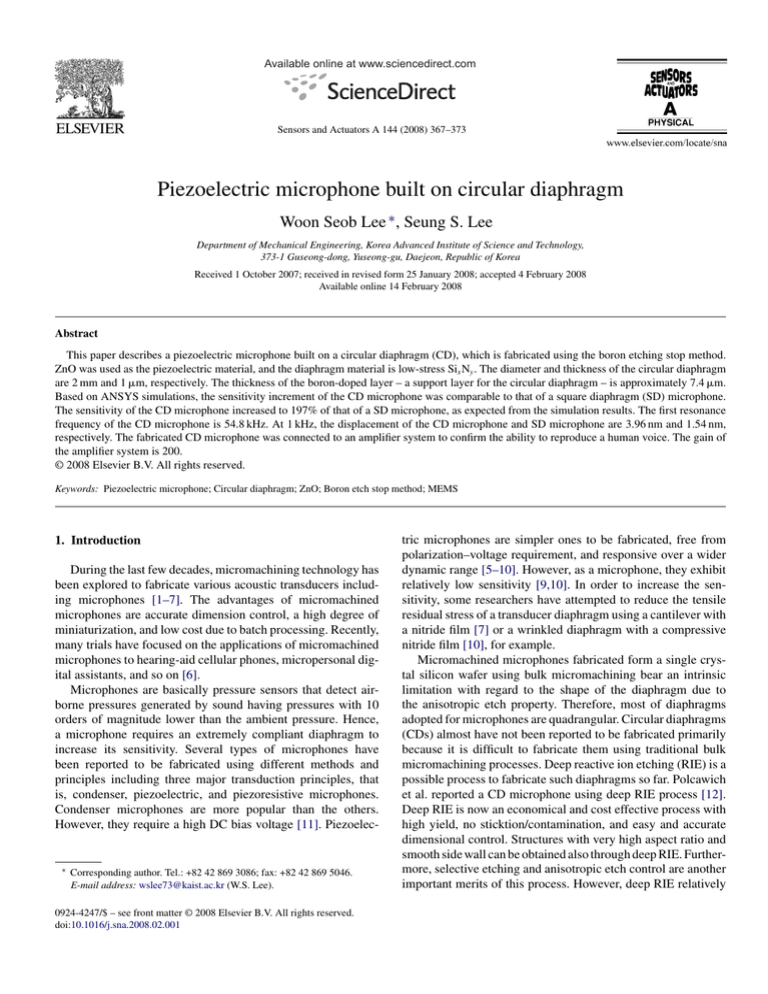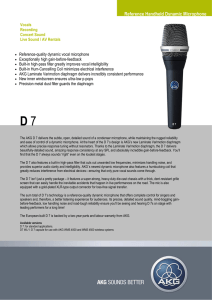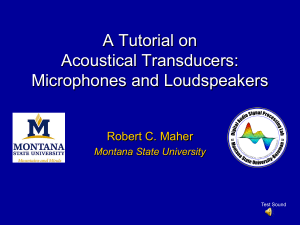
Available online at www.sciencedirect.com
Sensors and Actuators A 144 (2008) 367–373
Piezoelectric microphone built on circular diaphragm
Woon Seob Lee ∗ , Seung S. Lee
Department of Mechanical Engineering, Korea Advanced Institute of Science and Technology,
373-1 Guseong-dong, Yuseong-gu, Daejeon, Republic of Korea
Received 1 October 2007; received in revised form 25 January 2008; accepted 4 February 2008
Available online 14 February 2008
Abstract
This paper describes a piezoelectric microphone built on a circular diaphragm (CD), which is fabricated using the boron etching stop method.
ZnO was used as the piezoelectric material, and the diaphragm material is low-stress Six Ny . The diameter and thickness of the circular diaphragm
are 2 mm and 1 m, respectively. The thickness of the boron-doped layer – a support layer for the circular diaphragm – is approximately 7.4 m.
Based on ANSYS simulations, the sensitivity increment of the CD microphone was comparable to that of a square diaphragm (SD) microphone.
The sensitivity of the CD microphone increased to 197% of that of a SD microphone, as expected from the simulation results. The first resonance
frequency of the CD microphone is 54.8 kHz. At 1 kHz, the displacement of the CD microphone and SD microphone are 3.96 nm and 1.54 nm,
respectively. The fabricated CD microphone was connected to an amplifier system to confirm the ability to reproduce a human voice. The gain of
the amplifier system is 200.
© 2008 Elsevier B.V. All rights reserved.
Keywords: Piezoelectric microphone; Circular diaphragm; ZnO; Boron etch stop method; MEMS
1. Introduction
During the last few decades, micromachining technology has
been explored to fabricate various acoustic transducers including microphones [1–7]. The advantages of micromachined
microphones are accurate dimension control, a high degree of
miniaturization, and low cost due to batch processing. Recently,
many trials have focused on the applications of micromachined
microphones to hearing-aid cellular phones, micropersonal digital assistants, and so on [6].
Microphones are basically pressure sensors that detect airborne pressures generated by sound having pressures with 10
orders of magnitude lower than the ambient pressure. Hence,
a microphone requires an extremely compliant diaphragm to
increase its sensitivity. Several types of microphones have
been reported to be fabricated using different methods and
principles including three major transduction principles, that
is, condenser, piezoelectric, and piezoresistive microphones.
Condenser microphones are more popular than the others.
However, they require a high DC bias voltage [11]. Piezoelec-
∗
Corresponding author. Tel.: +82 42 869 3086; fax: +82 42 869 5046.
E-mail address: wslee73@kaist.ac.kr (W.S. Lee).
0924-4247/$ – see front matter © 2008 Elsevier B.V. All rights reserved.
doi:10.1016/j.sna.2008.02.001
tric microphones are simpler ones to be fabricated, free from
polarization–voltage requirement, and responsive over a wider
dynamic range [5–10]. However, as a microphone, they exhibit
relatively low sensitivity [9,10]. In order to increase the sensitivity, some researchers have attempted to reduce the tensile
residual stress of a transducer diaphragm using a cantilever with
a nitride film [7] or a wrinkled diaphragm with a compressive
nitride film [10], for example.
Micromachined microphones fabricated form a single crystal silicon wafer using bulk micromachining bear an intrinsic
limitation with regard to the shape of the diaphragm due to
the anisotropic etch property. Therefore, most of diaphragms
adopted for microphones are quadrangular. Circular diaphragms
(CDs) almost have not been reported to be fabricated primarily
because it is difficult to fabricate them using traditional bulk
micromachining processes. Deep reactive ion etching (RIE) is a
possible process to fabricate such diaphragms so far. Polcawich
et al. reported a CD microphone using deep RIE process [12].
Deep RIE is now an economical and cost effective process with
high yield, no sticktion/contamination, and easy and accurate
dimensional control. Structures with very high aspect ratio and
smooth side wall can be obtained also through deep RIE. Furthermore, selective etching and anisotropic etch control are another
important merits of this process. However, deep RIE relatively
368
W.S. Lee, S.S. Lee / Sensors and Actuators A 144 (2008) 367–373
Fig. 2. Schematic diagram of the structure of a circular diaphragm.
distribution of the maximum stress is uniform along the circumference of a circular diaphragm, while that of a square diaphragm
is distributed along a part of the edges. It is possible to locate the
electrode on the circumference in case of a circular diaphragm.
The circular diaphragm could be expected to have greater sensitivity than the square one even if the electrode is fabricated on the
same area over the maximum stress area because the sensitivity
of a piezoelectric microphone follows [12]:
sensitivity =
Fig. 1. Simulation results comparing stress distributions of a circular diaphragm
(a) and a square diaphragm (b), and the small square boxes show areas of effective
electrodes.
costs more than wet bulk etching process. In addition, isotropic
etching has another flexible application area although it is difficult to control the dimension and shape of a diaphragm and
maintain the reproducibility.
In this paper, the boron etch stop method is used to fabricate a
circular diaphragm [13–17]. A circular diaphragm has uniform
stress distribution that contributes to increasing the sensitivity
when applied to a piezoelectric microphone.
2. Simulation and design
Finite element modeling with ABAQUS software and
ANSYS has been performed to study the difference between
the mechanical behavior and stress distribution of circular and
square diaphragms (SDs) and to determine whether changing
the shape of the diaphragm will increase the sensitivity or not.
Static analysis has been performed to obtain the stress distribution in the circular and square diaphragms under uniform
pressure load (1 Pa), as shown in Fig. 1. The diameter of the circular diaphragm is 2 mm and its thickness is 1 m; the SD has
the same area and thickness as the circular diaphragm. Table 1
shows the material properties used in these simulations. The
Table 1
Material properties used in analysis
Material
Young’s modulus (GPa)
Poisson’s ratio
Density (kg/m3 )
Six Ny
Si
85
125
0.25
0.22
3100
2330
Apiezo σd31
Cload + Cpiezo
(1)
Apiezo denotes the area of the piezoelectric; σ, the applied
stress; d31 , the transverse piezoelectric coefficient; Cload , the
load capacitance; Cpiezo , the capacitance of the piezoelectric.
The effective electrode area was divided into three parts – 15%,
30%, and 40% of the diaphragm area – to calculate the increase in
sensitivity, as shown in Fig. 2. Table 2 shows the ratio of σ circular
to σ square according to the increase in the effective electrode
area. The ratio of σ circular to σ square increased with an increase
in the area of the electrode: 150%, 168%, and 186%. 30% of the
diaphragm area was chosen as the electrode area, as mentioned
in Table 2.
Boron etch stop method was used to fabricate a circular
diaphragm as shown in Fig. 2. Simulation has been performed
to determine the thickness of boron-doped layer. Static analysis has been performed to obtain the displacement in circular
diaphragms by the change of the thickness of boron-doped layer
under uniform pressure load (1 Pa), as shown in Fig. 3. The size
of a side of boron-doped layer which is open is 2.1 mm, and the
circular diaphragm is located inside of the boron-doped layer.
The diameter and thickness of the circular diaphragm are same
as designed previously. Fig. 3 shows the results of simulations.
When the thickness of the boron-doped layer is over 6 m, the
displacement, when doped, is approximately 1/1000 that of the
undoped membrane as the same load applied. Therefore, the
thickness of the boron-doped layer is designed to be over 7 m
Table 2
The ratio of σ circular to σ square according to the increase in area under the stressed
region
Effective electrode area/diaphragm area (%)
σ circular /σ square (%)
15
30
40
150
168
186
W.S. Lee, S.S. Lee / Sensors and Actuators A 144 (2008) 367–373
369
Fig. 3. The magnitude of displacement of a boron-doped layer according to the change of the thickness of a boron-doped layer. (a) and (b) The simulation results of
the diaphragm displacement; (c) and (d) the displacement on points of A and B, respectively; (e) and (f) the change of displacement through line a and b, respectively.
in this fabrication. Fig. 3(e) and (f) shows the magnitude of displacement of two cases; the first one has a boron-doped layer of
which the thickness is 7 m and the second one does not have a
boron-doped layer. The displacement of the doped membrane is
approximately 1/10,000 that of the undoped membrane as shown
in Fig. 3.
3. Device fabrication
Microphones were fabricated simultaneously on circular and
square diaphragms to compare the functional differences of the
microphones based on each type of diaphragm.
Fig. 4 shows the fabrication process of the microphones. The
circular diaphragm microphone was fabricated on the circular
diaphragm, as shown in Fig. 4(a)–(e). In the fabrication process,
a 4-in. p-type silicon (Si) wafer was covered with a silicon oxide
(SiO2 ) layer of 1 m thickness by thermal oxidation to prevent
boron from diffusing into silicon. The SiO2 layer was patterned
to guide the desired high doping of boron. Boron diffused from
the solid source for 15 h at 1100 ◦ C in N2 environment. SiO2
was removed immediately after boron doping. Subsequently,
another SiO2 layer with a thickness of 0.2 m was deposited
by LPCVD to prevent boron from diffusing into the SiO2 layer
during thermal oxidation. An LPCVD low-stress silicon nitride
(Six Ny ) layer was deposited with a thickness of 1 m as a membrane material. An anisotropic etchant, 20 wt.% of tetramethyl
ammonium hydroxide (TMAH), was used to expose the silicon nitride diaphragm for 12 h at 90 ◦ C by etching the Si wafer
from the backside (bottom side in Fig. 4(e)). A photograph and
scanning electron microscopy (SEM) image of the completed
circular diaphragm are shown in Fig. 5(a) and (b), respectively.
The measured diameter of the diaphragm is 2 mm, as designed.
The thickness of the boron-doped layer, measured by SEM and
a 3D surface profiler, is approximately 7.5 m, as shown in
Fig. 5(c) and (d).
The fabrication of circular diaphragm microphones commenced with the circular diaphragm. A 0.3-m thick aluminum
(Al) layer was formed by evaporation with an E-beam evap-
370
W.S. Lee, S.S. Lee / Sensors and Actuators A 144 (2008) 367–373
Fig. 4. Fabrication process of the piezoelectric microphone: (a)–(e) circular diaphragm and (f)–(i) piezoelectric microphone.
orator as a bottom electrode. The bottom electrode was
patterned on LPCVD low-stress silicon nitride. A thick silicon oxide layer – 0.2 m thick – was deposited by PECVD
in order to form an electrical passivation layer. RIE was
used to etch SiO2 . Subsequently, a 0.8-m thick zinc oxide
(ZnO) layer was deposited by sputtering in an RF sputter
for 2 h. Al was evaporated on this ZnO layer to form a 0.3m thick layer. The Al layer was patterned to form the top
electrodes. Fig. 5(e) shows the fabricated piezoelectric microphones.
4. Experimental results
4.1. Displacement of diaphragm
The displacement and resonance frequency at the center of
the diaphragms was measured with a laser Doppler vibrometer (LDV) in the 100–200 kHz range to supply 1Vpk to the
microphones. Fig. 6 shows the characteristics of the displacement at the center of the diaphragm. From these results, the
first resonance frequencies of the CD microphone and SD
microphone were 54.8 kHz and 56.1 kHz, and their displacements were 77 nm and 82 nm, respectively. The displacements
of these devices were 3.96 nm and 1.54 nm at 1 kHz, as shown
in Fig. 6. Therefore, these results show that the displacement
of the CD microphone is larger than twice that of the SD
microphone.
4.2. Sensitivity of the microphone
The fabricated devices were tested to examine the characteristics of the output voltage for input acoustic pressure by
the FFT analyzer. A dynamic speaker was used as the input
acoustic pressure source for the fabricated microphones, and
the B&K 4190 microphone was used as a reference microphone. Fig. 7 shows the unamplified output voltages of the
circular and square diaphragm microphone in the 400 Hz to
10 kHz range using a supply voltage of 1Vpk of dynamic speaker.
The average sensitivity of the circular diaphragm microphone
(Sc ) and square diaphragm microphone (Ss ) was 39.6 V/Pa
and 20.1 V/Pa, respectively. Sc /Ss was 197% as expected from
the simulation results. The difference between the measurement results and simulation ones was within the error margin.
This shows that Sc was stable in the entire range. The response
characteristics of the unamplified CD microphone were compared with those of the B&K 4190 reference microphone as
shown in Fig. 8. Both microphones showed similar sensing
abilities.
W.S. Lee, S.S. Lee / Sensors and Actuators A 144 (2008) 367–373
371
Fig. 5. Pictures of circular diaphragms and microphones: (a) and (b) circular diaphragm, (c) and (d) thickness measurement results of boron-doped layer, and (e)
fabricated microphones.
Fig. 6. Displacements of the circular and square diaphragm microphone in
100 Hz to 200 kHz range.
Fig. 7. Unamplified sensitivities of the circular and square diaphragm microphone in the audio-frequency range.
372
W.S. Lee, S.S. Lee / Sensors and Actuators A 144 (2008) 367–373
Fig. 8. Response characteristic of the circular diaphragm microphone in the
audio-frequency range.
Fig. 10. Response characteristic of the circular diaphragm microphone system
in the audio-frequency range.
5. Conclusion
Fig. 9 shows the amplifier circuit for testing the response
characteristics to a human voice. The function of the CD microphone was tested by using this circuit, which was packaged
in a metal box to isolate from electric noise. The gain of the
amplifier is 200. The sensitivity of the CD microphone with this
amplifier was 8.1 mV/Pa on average using a supply voltage of
1Vpk . The system shown in Fig. 9(c) was able to clearly reproduce the human voice. The response characteristics of the CD
microphone system were compared with those of the B&K 4190
reference microphone, as shown in Fig. 10. Both microphones
showed similar sensing abilities. The white noise which existed
below 500 Hz, as shown in Fig. 8, was removed with the amplifier
system.
A piezoelectric microphone built on a circular diaphragm was
designed, fabricated, and verified. The circular diaphragm was
fabricated by using the boron etching stop method. The thickness of the boron-doped layer was approximately 7.5 m. It
was confirmed experimentally that its boron-doped layer could
be used as a support layer for the diaphragm. Based on simulations, the sensitivity was expected to increase on changing
the shape of the diaphragms. Compared with the sensitivity of
the SD microphone, that of the CD microphone increased, as
expected from the simulation results; furthermore, the output of
the CD microphone was very stable. The CD microphone system
with an amplifier was also confirmed to have a similar sensing
ability of that of the B&K 4190 reference microphone.
Acknowledgments
This research was supported by the center for intelligent
robotics, which carries out one of the 21st century’s Frontier
R&D Projects sponsored by the Korea Ministry of Commerce,
Industry and Energy. We would like to thank Dr. S.C. Ko and
C.H. Choi for their experimental assistance.
References
Fig. 9. Circuit of the amplifier and portable package: C1–C5 = 10 F,
C6 = 0.047 F, C7 = 220 F, and R1 = 10 .
[1] M. Royer, J.O. Holmen, M.A. Wurm, O.S. Aadland, M. Glenn, ZnO on Si
integrated acoustic sensor, Sens. Actuators A 4 (1983) 357–362.
[2] R. Schellin, G. Hess, A silicon subminiature microphone based on piezoresistive polysilicon strain gauges, Sens. Actuators A 32 (1992) 555–559.
[3] D. Hohm, R. Gerhard-Multhaupt, Silicon-dioxide electret transducer, J.
Acoust. Soc. Am. 75 (4) (1984) 1297–1298.
[4] P.R. Scheeper, A.G.H. van der Donk, W. Olthuis, P. Bergveld, A review of
silicon microphones, Sens. Actuators A 44 (1994) 1–11.
[5] M.N. Niu, E.S. Kim, Piezoelectric bimorph microphone built on micromachined parylene diaphragm, J. Microelectromech. Syst. 12 (6) (2003)
892–898.
[6] S.C. Ko, Y.C. Kim, S.S. Lee, S.H. Choi, S.R. Kim, Micromachined piezoelectric membrane acoustic device, Sens. Actuators A 103 (2003) 130–134.
W.S. Lee, S.S. Lee / Sensors and Actuators A 144 (2008) 367–373
[7] S.S. Lee, R.P. Ried, R.M. White, Piezoelectric cantilever microphone and
microspeaker, J. Microelectromech. Syst. 5 (4) (1996) 238–242.
[8] W. Kuhnel, G. Hess, Micromachined subminiature condenser microphones
in silicon, Sens. Actuators A 32 (1992) 560–564.
[9] C.H. Han, E.S. Kim, Fabrication of dome-shaped diaphragm with circular clamped boundary on silicon substrate, in: Proceedings of the IEEE
Conference MEMS, Orlando, USA, 1999, pp. 505–510.
[10] S.H. Yi, E.S. Kim, Piezoelectric microspeaker with compressive nitride
diaphragm, in: Proceedings of the IEEE Conference MEMS, Las Vegas,
USA, 2002, pp. 260–263.
[11] J.J. Neumann Jr., K.J. Gabriel, CMOS-MEMS membrane for audiofrequency acoustic actuation, Sens. Actuators A 95 (2002) 175–182.
[12] R.G. Polcawich, M. Scanlon, J. Pulskamp, J. Clarkson, J. Conred, D. Washington, R. Piekarz, S. Trolier-Mckinstry, M. Dubey, Design and fabrication
of a lead zirconate titanate (PZT) thin film acoustic sensor, Integr. Ferroelectr. 54 (2003) 595–606.
[13] J.C. Greenwood, Ethylene diamine–cathechol–water mixture shows preferential etching of p–n junction, J. Electrochem. Soc. 116 (1969) 1325–
1326.
[14] O.C. Jeong, S.S. Yang, Fabrication and test of a thermopneumatic miropump with a corrugated p+ diaphragm, Sens. Actuators A 83 (2000)
249–255.
[15] M. Gel, I. Shimoyama, Sub-micron thick high sensitive piezoresistive contilevers by boron etch stop and argon implantation, in: Proceedings of the
IEEE Conference MEMS, Kyoto, Japan, 2003, pp. 494–497.
[16] M.J. Madou, Fundamentals of Microfabrication, 2nd ed., CRC Press LLC,
New York, 2002.
[17] E. Manea, I. Cernica, V. Dolocan, R. Muller, Residual stress analysis in
thin membranes obtained by boron diffusion processes, in: Proceedings of
Semiconductor Conference, Sinaia, Romania, 2000, pp. 471–474.
373
Biographies
Woon Seob Lee He received his BS and MS degrees
in the Department of Materials Science and Engineering of the Soonchunhyang University, Korea, in 2000
and 2002, respectively. He was a researcher in the
Department of Mechanical Engineering at POSTECH
from 2002 to 2003. He has been a PhD candidate in
the Department of Mechanical Engineering from the
Korea Advanced Institute of Science and Technology
(KAIST) from 2003. He is interested in MEMS devices
including acoustic transducers and display systems.
Seung S. Lee He received BS degree from Seoul
National University, Korea in 1984 and the MS degree
in mechanical engineering of University of California,
Berkeley, USA in 1989. After his MS degree, he joined
Berkeley Sensor and Actuator Center (BSAC) and got
his PhD degree there in 1995. After 1 year at Samsung
Advanced Institute of Technology (SAIT) in Kiheung,
Korea, he joined the Faculty of the Department of
Mechanical Engineering of Pohang University of Science and Technology (POSTECH), Korea, in 1997 and
became an associate professor there in 2003. He moved
from POSTECH to the Korea Advanced Science and Technology (KAIST) in
2003 as an associate professor of the Department of Mechanical Engineering
and currently working in KAIST as a professor. His recent research area includes
HARMST with LIGA process, Bio-MEMS, Microfluidics, and piezo-MEMS.




